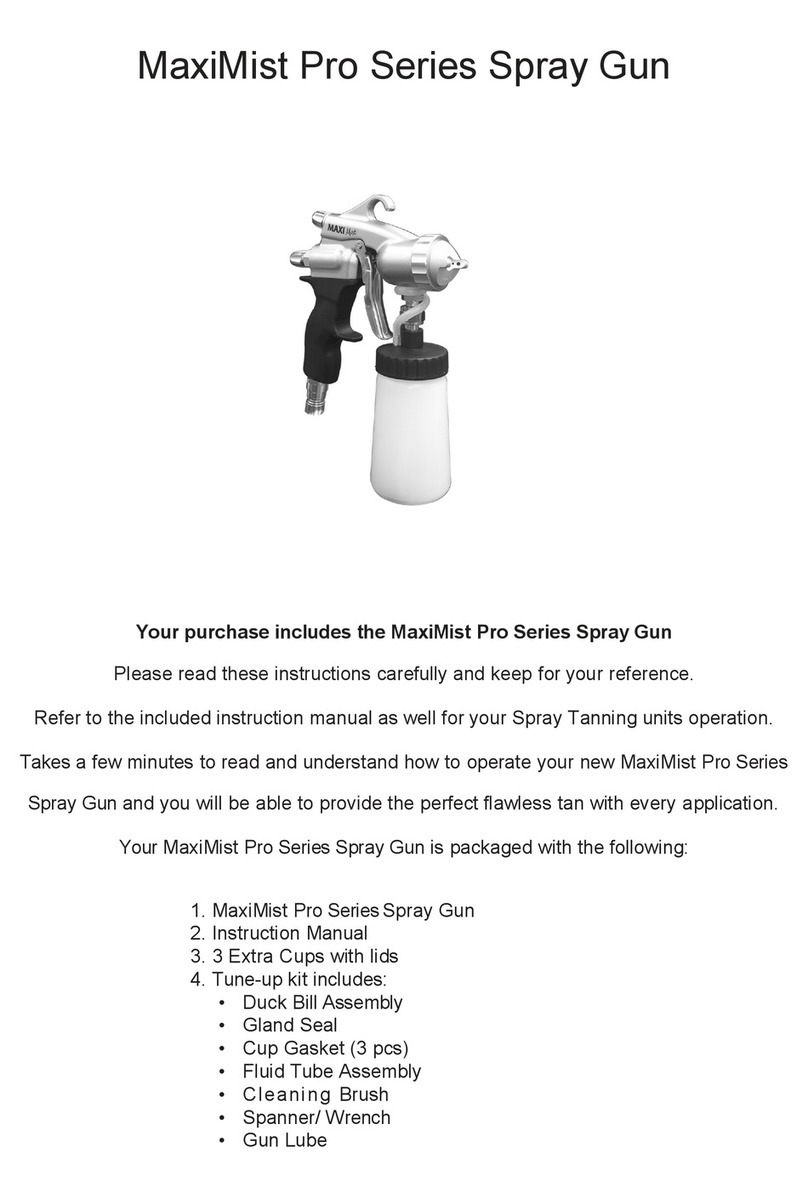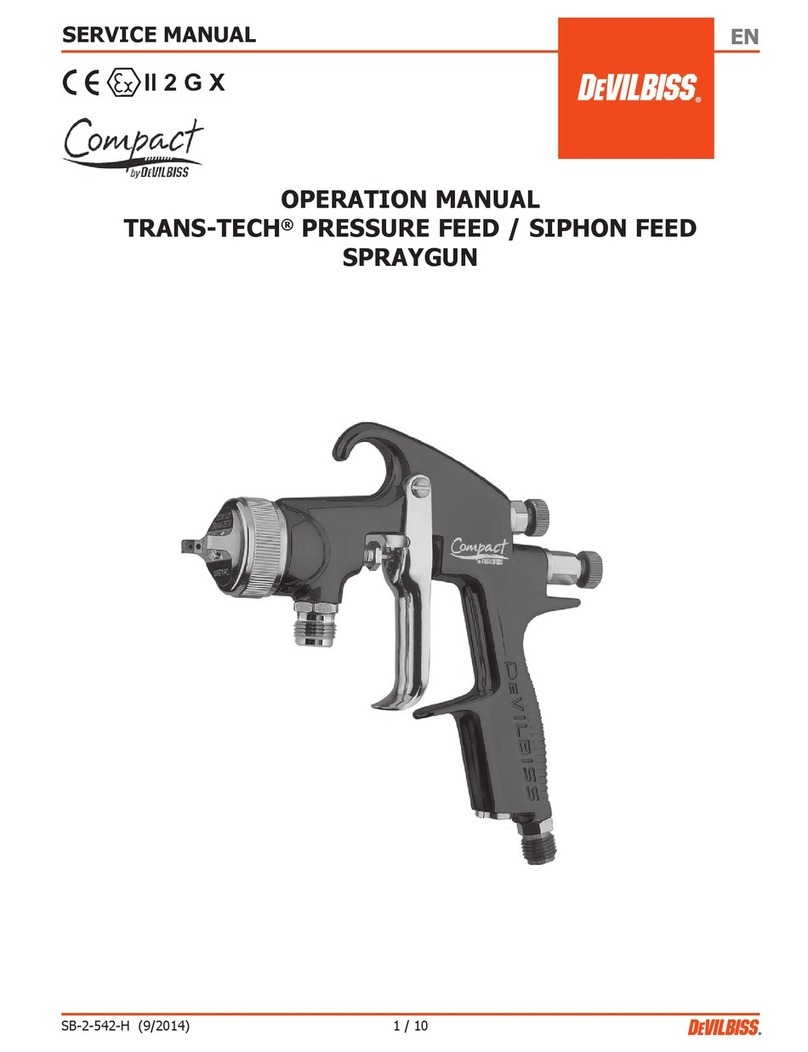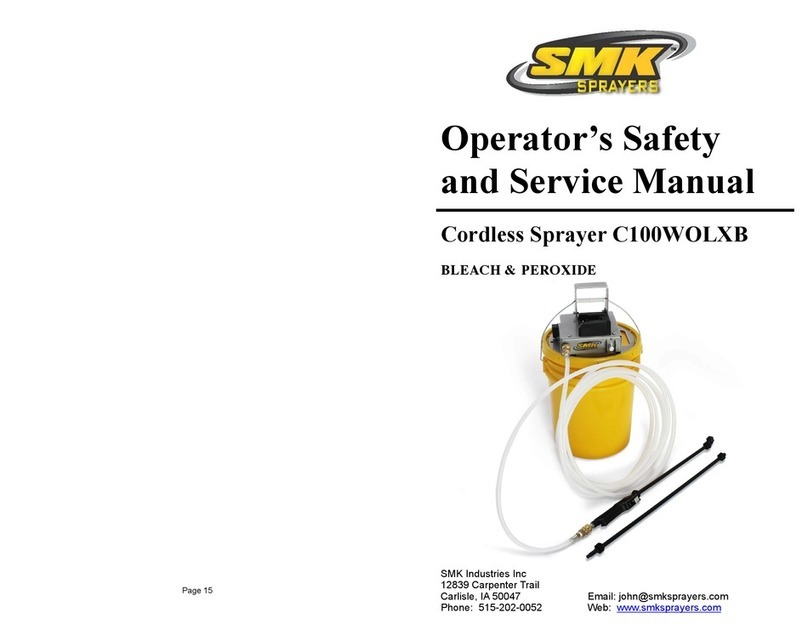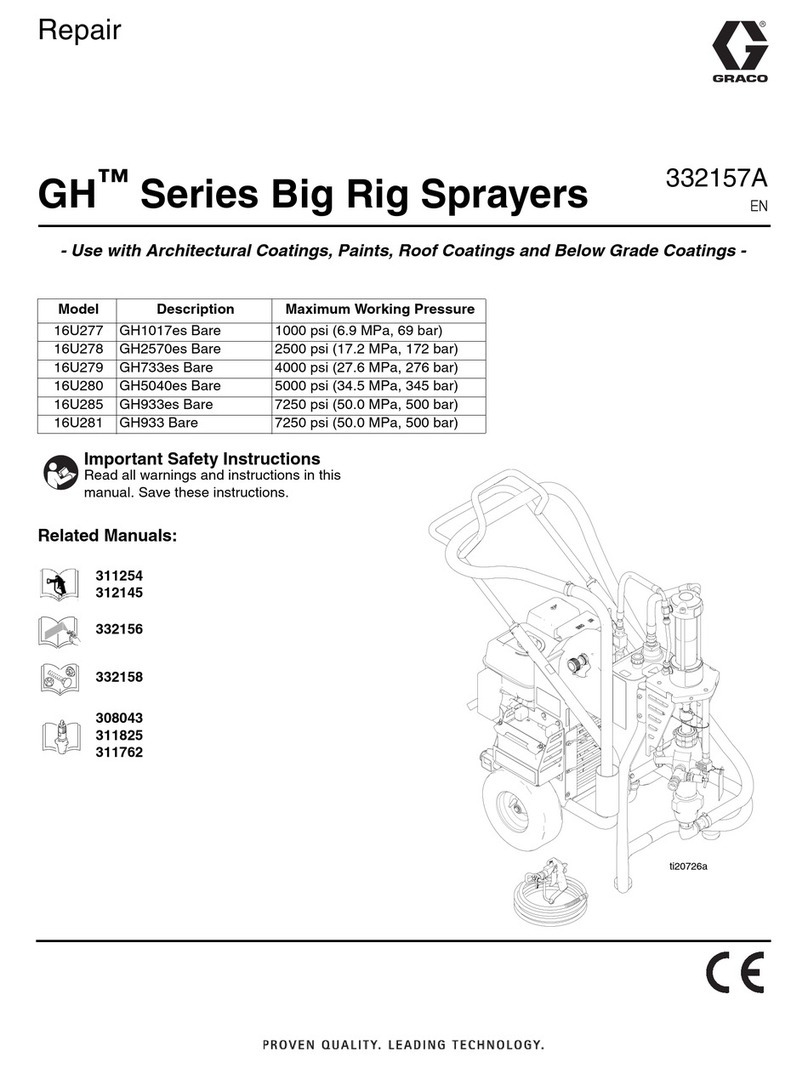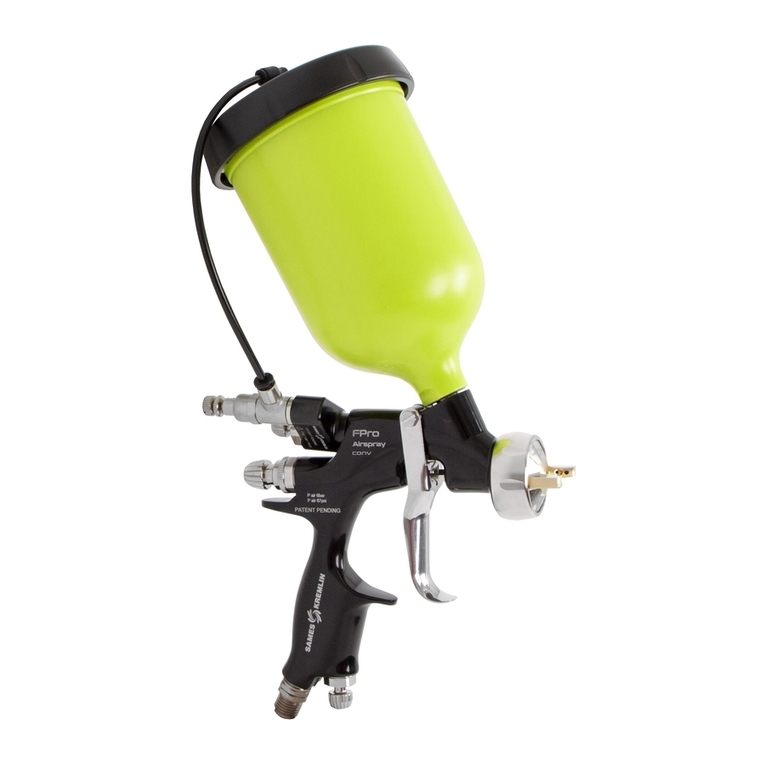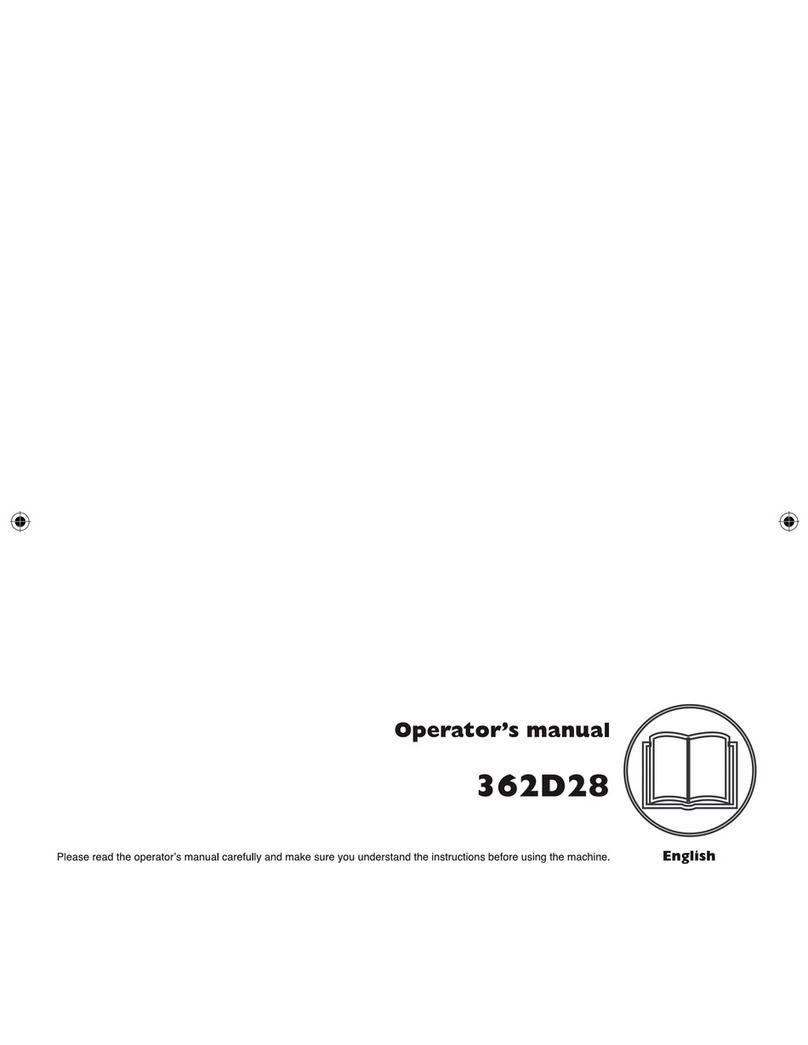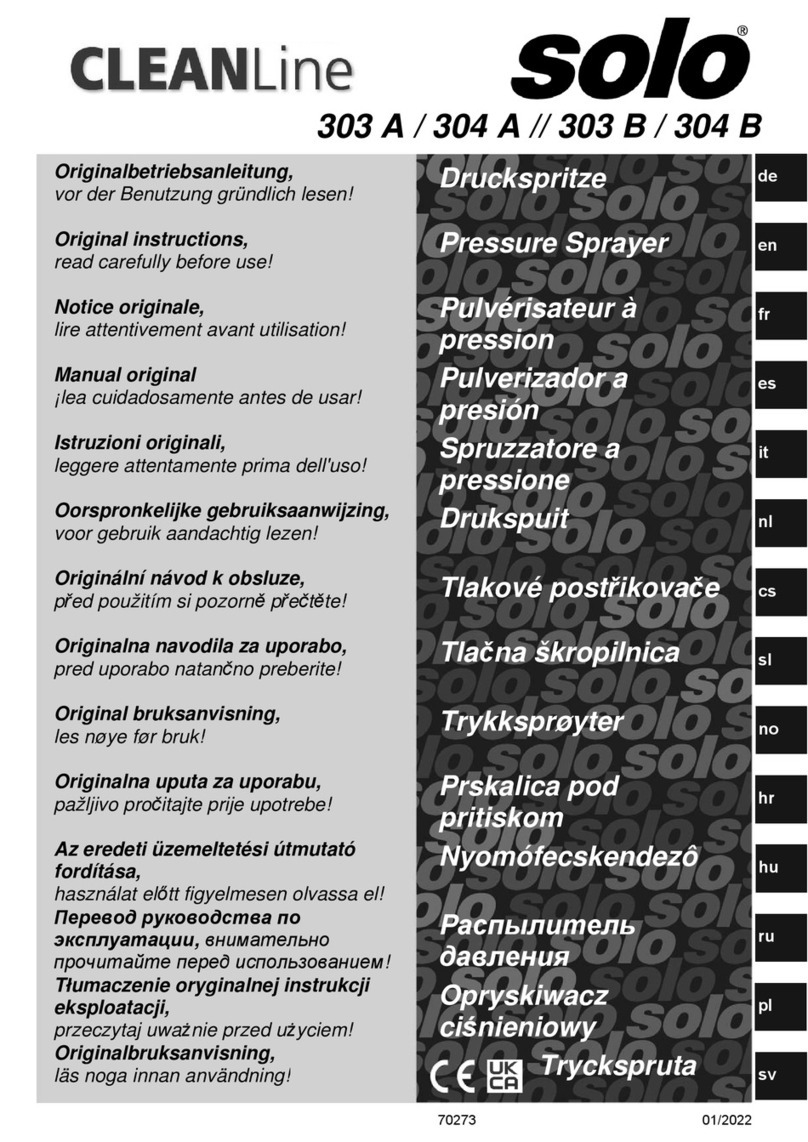Dino-Power DP-6840iB User manual

Operating Instruction
Product model:DP-6840iB airless paint sprayer
DP-6840iL
1.8 hp 3.5L
Stand-up cart
DP-6840iB
1.8 hp 3.5L
Low cart
Please read and keep this manual, Read carefully before attempting to assemble, install, operate or maintain the
product described. Protect yourself and others by observing all safety information. Failure to comply with instructions
could result in personal injury and/or property damage! Retain instruction for future reference..
www.dpairless.com www.dino-power.com www.airlesspaintsprayer-pump.com www.airless-paint-spray.com

Table of Contents
Safety Precautions .................................................................2
General Description ...............................................................4
Operation ................................................................................4
Setup ....................................................................................4
Preparing to Paint .................................................................4
Painting .................................................................................5
Electronic Pressure Control Indicators .................................6
Pressure Relief Procedure ...................................................6
Spraying ..................................................................................6
Spraying Technique ..............................................................6
Practice .................................................................................7
Cleanup ...................................................................................7
Cleaning the Spray Tip .........................................................7
Maintenance............................................................................8
General Repair and Service Notes.......................................8
Replacing the Motor Assembly .............................................8
Replacing the Gears .............................................................8
Replacing the Transducer.....................................................9
Replacing the PRIME/SPRAY Valve.....................................9
Servicing the Fluid Section .................................................10
Replacing the Filters ...........................................................11
Troubleshooting ...................................................................12
Parts Listings........................................................................14
Main Assembly....................................................................14
Drive Assembly ...................................................................15
Fluid Section Assembly ......................................................16
Filter Assembly ...................................................................17
PRIME/SPRAY Assembly ...................................................18
Accessories ........................................................................18
Safety Precautions
This manual contains information that must be read and
understood before using the equipment. When you come to an
area that has one of the following symbols, pay particular
attention and make certain to heed the safeguard.
Attention! Danger of injury by injection!
In case of injury to skin caused by coating materials or
solvents consult a doctor immediately. Inform the doctor of the
type of coating material or cleaning agent with which the injury
was caused.
The operating instructions state that the following points
must always be observed before starting up:
1. Faulty units should not be used.
2. Secure spray gun using the safety catch on the trigger.
3. Ensure that the unit is properly earthed.
4. Check the permissible operating pressures.
5. Check all connections for leaks.
The instructions regarding regular cleaning and
maintenance of the unit must be strictly observed.
Before any work is done on the unit or for every break in
work the following rules must be observed:
1. Release the pressure from the spray gun and hose.
2. Secure the spray gun using the safety catch on the
trigger.
3. Turn off the motor.
Be safety-conscious!
All local regulations in force must be observed.
In order to ensure safe operation of the airless systems
the safety regulations listed below must be followed:
1. In order to avoid dangers, read the operating instructions
carefully and follow the instructions laid down in them.
2. Do not use materials with a flash point below 21ºC (70ºF).
3. The use of this unit is prohibited in workshops which are
covered under the explosion prevention regulations.
4. Never spray near sources of ignition; e.g. open flames,
cigarettes — also cigars and pipes are sources of ignition
— sparks, hot wires and hot surfaces, etc.
5. Attention! Danger of injury by injection!
Never point the spray gun at yourself or anyone else.
Never put your fingers or hands into the spray jet. The
very high spraying pressures can cause very serious
injuries. Never use the spray gun without the safety guard.
WARNING
This symbol indicates a potential hazard that may cause
serious injury or loss of life. Important safety information
will follow.
CAUTION
This symbol indicates a potential hazard to you or to the
equipment. Important information that tells how to prevent
damage to the equipment or how to avoid causes of minor
injuries will follow.
NOTE: Notes give important information which should
be given special attention.
WARNING
Airless units develop extremely high spraying pressures.
• Never put your fingers, hands or any other parts of the
body into the spray jet.
• Never point the spray gun at yourself or anybody else.
• Never use the spray gun without the safety guard.
When installing and removing the tip and during breaks in
work the spray gun must always be secured, so that it
cannot be activated.
6. Wear respiratory equipment when spraying. The operator
must be provided with a protective mask.
In order to prevent work related illness, the manufacturer's
regulations for the materials, solvents, and cleaning
agents used must be observed when preparing, working
with and cleaning the unit. Protective clothing, gloves and,
in certain cases, protective skin cream are necessary to
protect the skin.
7. The spray gun and high pressure hose between the unit
and spray gun must be of a sufficient standard for the
pressure produced in the unit.
The permissible operating pressure for the high-pressure
hose, the manufacturer and date of manufacture must be
indicated by a permanent identification marking on the
hose. Furthermore, it must be constructed so that the
electrical resistance between the connections to the unit
and the spray gun is equal to or less than one megohm.
8. Under certain conditions the flow speed can cause an
electrostatic charge on the unit. This could cause sparks
or flames on discharging. It is, therefore, important that
the unit is always earthed over the electrical installation.
The contact should be made using a shockproof socket
earthed in accordance with the regulations.
DP airless sprayer Page 2 of 18

9. Attention! Please observe the following when working
inside and outside:
No solvent gasses should be carried to the unit. No
solvent gasses should form near the unit. Set up the unit
on the opposite side to the object being sprayed. When
spraying outdoors, take the wind direction into account.
When working indoors there must be sufficient ventilation
to ensure that the solvent gasses are carried away. A
minimum distance of 6.1m (20’) must be observed
between the unit and object being sprayed.
10. Extraction equipment should be installed by the user in
accordance with the local regulations.
11. The objects being sprayed must be earthed.
12. When cleaning the unit, solvent should never be sprayed
into a container with only a small opening (bunghole). An
explosive gas/air mixture is likely to form. The container
must be earthed.
13. Cleaning the unit.
A harsh jet should never be used to spray the unit. In
particular a high-pressure cleaner or high-pressure steam
cleaner should never be used. There is a danger that
water will penetrate into the unit and cause a short-circuit.
14. Pulling the trigger causes a recoil force to the hand that is
holding the spray gun.
The recoil force of the spray gun is particularly powerful
when the tip has been removed and a high pressure has
been set on the airless high-pressure pump. Therefore,
when cleaning without tip set the pressure control valve to
the lowest pressure.
15. The mains plug should always be disconnected from the
socket when work is being carried out on the electrical
components.
16. Work or repairs should only be carried out on electrical
equipment by a trained electrician, even if the work is
described in the operating instructions. No liability will be
accepted for incorrectly installed electrics.
17. Positioning when the ground is uneven.
The front of the unit must point downward so that the
machine does not slip away.
HAZARD: INJECTION INJURY - A high pressure stream
of paint produced by this equipment can pierce
the skin and underlying tissues, leading to
serious injury and possible amputation.
DO NOT TREAT AN INJECTION INJURY AS A
SIMPLE CUT! Injection can lead to
amputation. See a physician immediately.
PREVENTION:
• The maximum operating range of the unit is 228 BAR
(3300 PSI) fluid pressure.
• NEVER aim the gun at any part of the body.
• NEVER allow any part of the body to come in contact with
the fluid stream. DO NOT come in contact with a fluid
stream created by a leak in the fluid hose.
• NEVER put your hand in front of the gun. Gloves will not
provide protection against an injection injury.
• ALWAYS lock the gun trigger, shut the fluid pump off and
release all pressure before servicing, cleaning the tip
guard, changing tips, or leaving unattended. Pressure will
not be released by turning off the engine. The
PRIME/SPRAY knob must be turned to PRIME to relieve
the pressure. Refer to the PRESSURE RELIEF
PROCEDURE described in this manual.
• The tip guard must always be in place while spraying. The
tip guard provides some protection against injection
injuries but is mainly a warning device.
• ALWAYS remove the spray tip before flushing or cleaning
the system.
• The paint hose can develop leaks from wear, kinking and
abuse. A leak is capable of injecting material into the skin.
Inspect the paint hose before each use.
NOTE TO PHYSICIAN:
Injection into the skin is a traumatic injury. It is
important to treat the injury surgically as soon as
possible. DO NOT delay treatment to research toxicity.
Toxicity is a concern with some coatings injected
directly into the blood stream. Consultation with a
plastic surgeon or reconstructive hand surgeon may be
advisable.
HAZARD: EXPLOSION OR FIRE - Solvent and paint fumes
can explode or ignite, causing property damage
and/or severe injury.
PREVENTION:
• Fire extinguishing equipment must be present and in good
working order.
• Use only conductive or earthed high pressure fluid hoses
for airless applications. Be sure that the gun is earthed
properly through hose connections.
• The pump must be connected to an earthed object. Use
the green earthing wire to connect the pump to a water
pipe, steel beam, or other electrically earthed surface.
• When flushing equipment use the lowest possible
pressure.
HAZARD: EXPLOSION HAZARD DUE TO INCOMPATIBLE
MATERIALS- May cause property damage or
severe injury.
PREVENTION:
• Do not use bleach.
• Do not use halogenated hydrocarbon solvents such as
methylene chloride and 1,1,1 - trichloroethane. They are
not compatible with aluminum and may cause an
explosion. If you are unsure of a material’s compatibility
with aluminum, contact your coating's supplier.
HAZARD: GENERAL - May cause property damage or
severe injury.
PREVENTION:
• This high pressure airless pump is designed to be used
with manufacturer authorized parts only. When using this
pump with parts that do not comply with the minimum
specifications and safety devices of the pump
manufacturer, the user assumes all risks and liabilities.
• Before each use, check all hoses for cuts, leaks, abrasion
or bulging of cover, as well as damage or movement of
couplings. If any of these conditions exist, replace the
hose immediately. Never repair a paint hose. Replace it
with another earthed hose.
• Wear protective eyewear.
• Do not spray on windy days.
Earthing Instructions
This product must be earthed. In the event of an electrical
short circuit, earthing reduces the risk of electric shock by
providing an escape wire for the electric current. This product
is equipped with a cord having an earthing wire with an
appropriate earthing plug. The plug must be plugged into an
outlet that is properly installed and earthed in accordance with
all local codes and ordinances.
DANGER — Improper installation of the earthing plug can
result in a risk of electric shock.
If repair or replacement of the cord or plug is necessary, do not
connect the green earthing wire to either flat blade terminal.
The wire with insulation having a green outer surface with or
without yellow stripes is the earthing wire and must be
connected to the earthing pin.
Check with a qualified electrician or serviceman if the earthing
instructions are not completely understood, or if you are in
doubt as to whether the product is properly earthed. Do not
modify the plug provided. If the plug will not fit the outlet, have
the proper outlet installed by a qualified electrician.
DP-airless Page 3 of 18

General Description
This airless sprayer is a precision power tool used for spraying
many types of materials. Read and follow this instruction
manual carefully for proper operating instructions,
maintenance, and safety information.
CAUTION
Always use a minimum 12 gauge, three-wire extension
cord with a grounded plug. Never remove the third prong
or use an adapter.
Preparing a New Sprayer
Pressure
Control
Knob
Electronic
Pressure
Control
Indicators
Oil Cup
Fluid
Section
Siphon
Tube
Outlet
Fitting
Motor
Filter
PRIME/
SPRAY
Valve
If this unit is new, it is shipped with test fluid in the fluid section
to prevent corrosion during shipment and storage. This fluid
must be thoroughly cleaned out of the system with mineral
spirits before you begin spraying.
CAUTION
Always keep the trigger lock on the spray gun in the
locked position while preparing the system.
1. Place the siphon tube into a container of mineral spirits.
2. Place the return hose into a metal waste container.
3. Move the PRIME/SPRAY valve down to the PRIME
position.
4. Turn the unit on and set the pressure to minimum by
turning the pressure control knob to the “Min PSI” with
low pressure setting.
Operation
WARNING
This equipment produces a fluid stream at extremely high
pressure. Read and understand the warnings in the
Safety Precautions section at the front of this manual
before operating this equipment.
Pressure Control Knob
5. Allow the sprayer to run for 15–30 seconds to flush the
test fluid out through the return hose and into the waste
container.
6. Turn the unit off by moving the pressure control knob to
the OFF position.
Setup
Perform the following procedure before plugging in the power
cord of an electric unit.
1. Ensure that the siphon tube/siphon set and the return
hose are attached and secure.
2. Using a wrench, attach a minimum of 15m (50’) x 10mm
(1/4”) nylon airless spray hose to the unit. Tighten
securely.
3. Attach an airless spray gun to the spray hose. Using two
wrenches (one on the gun and one on the hose), tighten
securely.
NOTE: Do not attach the tip to the spray gun yet.
Remove the tip if it is already attached.
Preparing to Paint
Before painting, it is important to make sure that the fluid in the
system is compatible with the paint that is going to be used.
NOTE: Incompatible fluids and paint may cause the
valves to become stuck closed, which would
require disassembly and cleaning of the
sprayer’s fluid section.
CAUTION
Always keep the trigger lock on the spray gun in the
locked position while preparing the system.
1. Place the siphon tube into a container of the appropriate
solvent. Examples of the appropriate solvent are water for
latex paint or mineral spirits for oil-based paints.
2. Place the return hose into a metal waste container.
3. Move the PRIME/SPRAY valve down to the PRIME
position.
4. Turn the unit on and set the pressure to
minimum by turning the pressure control
knob to the “Min PSI” with low pressure
setting.
5. Allow the sprayer to run for 15–30 seconds
to flush the old solvent out through the
return hose and into the metal waste
container.
6. Turn the unit off by moving the pressure control knob to
the OFF position.
NOTE: Make sure that the spray gun does not have a
tip or tip guard installed.
WARNING
Make sure all airless hoses and spray guns are electrically
grounded and rated for at least 228 bar (3300 psi) fluid
pressure.
4. Make sure the pressure control knob is in its OFF position
5. Fill the oil cup with 15g (one tablespoon) of piston seal
lubricant (Piston Lube).
CAUTION
Never operate unit for more than ten seconds without
fluid. Operating this unit without fluid will cause
unnecessary wear to the packings.
6. Make sure the electrical service is correct for the unit.
7. Plug the power cord into a properly grounded outlet at
least 7.6m (25’) from the spray area.
DP-airless Page 4 of 18

7. Move the PRIME/SPRAY valve up to the SPRAY position.
8. Turn the unit on and set the pressure to minimum by
turning the pressure control knob to the “Min PSI” with
low pressure setting.
9. Unlock the gun by turning the gun trigger lock to the
unlocked position.
WARNING
Ground the gun by holding it against the
edge of the metal container while
flushing. Failure to do so may lead to a
static electric discharge, which may
cause a fire.
10. Trigger the gun into the metal waste
container until the old solvent is gone and fresh solvent is
coming out of the gun.
11. Lock the gun by turning the gun
trigger lock to the locked position.
12. Set down the gun and increase the
pressure by turning the pressure
control knob slowly clockwise into the
Max. Pressure zone.Trigger lock
in locked position.
13. Check the entire system for leaks. If leaks occur, turn off
the unit and follow the “Pressure Relief Procedure” in this
manual before tightening any fittings or hoses.
14. Follow the “Pressure Relief Procedure” in this manual
before changing from solvent to paint.
12. Lock the gun by turning the gun trigger
lock to the locked position.
13. Turn the unit off by moving the
pressure control knob to the OFF
position.
Trigger lock14. Attach tip
guard and tip to the gun as
in locked position.instructed
by the tip guard or tip
manuals.
WARNING
POSSIBLE INJECTION HAZARD. Do not spray without the
tip guard in place. Never trigger the gun unless the tip is
in either the spray or the unclog position. Always engage
the gun trigger lock before removing, replacing or
cleaning tip.
15. Turn the unit on and set the pressure to minimum by
turning the pressure control knob to the “Min PSI” with
low pressure setting.
16. Increase the pressure by turning the pressure control
knob slowly clockwise toward the Max. zone and test the
spray pattern on a piece of cardboard. Adjust the
pressure control knob until the spray from the gun is
completely atomized.
NOTE: Turning the pressure up higher then needed to
atomize the paint will cause premature tip wear
and additional overspray.
WARNING
Be sure to follow the pressure relief procedure when
shutting the unit down for any purpose, including
servicing or adjusting any part of the spray system,
changing or cleaning spray tips, or preparing for cleanup.
Painting
1. Place the siphon tube into a container of paint.
2. Place the return hose into a metal waste container.
3. Move the PRIME/SPRAY valve down to the PRIME
position.
4. Turn the unit on and set the pressure to
minimum by turning the pressure control
knob to the “Min PSI” setting in the yellow
zone.
5. Allow the sprayer to run until paint is
coming through the return hose into the
metal waste container.
6. Turn the unit off by moving the pressure control knob to
the OFF position in the black zone.
7. Remove the return hose from the waste container and
place it in its operating position above the container of
paint.
8. Move the PRIME/SPRAY valve up to the SPRAY position.
9. Turn the unit on and set the pressure to minimum by
turning the pressure control knob to the “Min PSI” setting
in the yellow zone.
10. Unlock the gun by turning the gun trigger lock to the
unlocked position.
WARNING
Ground the gun by holding it against the
edge of the metal container while
flushing. Failure to do so may lead to a
static electric discharge, which may
cause a fire.
11. Trigger the gun into the metal waste
container until all air and solvent is flushed from the spray
hose and paint is flowing freely from the gun.
DP-airless Page 5 of 18

Electronic Pressure Control Indicators
The following is a description of the electronic pressure control
indicators.
Spraying Technique
The following techniques, if followed, will assure professional
painting results.
Hold the gun perpendicular to the surface and always at equal
distance from the surface. Depending on the type of material,
surface, or desired spray pattern, the gun should be held at a
distance of 30 to 35 cm (12 to 14 inches).
Move the gun either across or up and down the surface at a
steady rate. Moving the gun at a consistent speed conserves
material and provides even coverage. The correct spraying speed
allows a full, wet coat of paint to be applied without runs or sags.
Holding the gun closer to the surface deposits more paint on
the surface and produces a narrower spray pattern. Holding
the gun farther from the surface produces a thinner coat and
wider spray pattern. If runs, sags, or excessive paint occur,
change to a spray tip with a smaller orifice. If there is an
insufficient amount of paint on the surface or you desire to
spray faster, a larger orifice tip should be selected.
Maintain uniform spray stroke action. Spray alternately from
left to right and right to left. Begin movement of the gun before
the trigger is pulled.
start
stroke
pull
trigger
release
trigger
end
stroke
Paint delivery volume botton.
To pressure the CONTROL botton for 3s, it will show the paint
delivery volume from starting the machine.
Pressure Relief Procedure
WARNING
Be sure to follow the pressure relief procedure when
shutting the unit down for any purpose, including
servicing or adjusting any part of the spray system,
changing or cleaning spray tips, or preparing for cleanup.
1. Lock the gun by turning the gun trigger
lock to the locked position.
2. Turn the pressure control knob
counterclockwise to its OFF position.
3. Unlock the gun by turning the gun
trigger lock to the unlocked position.
Trigger lock
in locked position.
Avoid arcing or holding the gun at an angle. This will result in
an uneven finish.
Offspray
4. Hold the metal part of the gun firmly to
the side of a metal container to ground
the gun and avoid a build up of static
electricity.
5. Trigger the gun to remove any pressure
that may still be in the hose.
6. Lock the gun by turning the gun trigger lock to the locked
position.
7. Move the PRIME/SPRAY valve down to the PRIME
position.
Too Thick
Arcing
Gun at angle
Spraying
NOTE: When spraying block fillers, mastics, or high
solid coatings, remove the gun filter and the
high pressure filter.
Proper lapping (overlap of spray pattern) is essential to an
even finish. Lap each stroke. If you are spraying horizontally,
aim at the bottom edge of the preceding stroke, so as to lap
the previous pattern by 50%.
Overlap edges
WARNING
POSSIBLE INJECTION HAZARD. Do not spray without the
tip guard in place. Never trigger the gun unless the tip is
in either the spray or the unclog position. Always engage
the gun trigger lock before removing, replacing, or
cleaning tip.
1st
pass
2nd
pass
3rd
pass
4th
pass
5th
pass
DP-airless Page 6 of 18

For corners and edges, split the
center of the spray pattern on the
corner or edge and spray vertically
so that both adjoining sections
receive approximately even
amounts of paint.
When spraying with a shield, hold it firmly against the surface.
Angle the spray gun slightly away from the shield and toward
the surface. This will prevent paint from being forced
underneath.
Shrubs next to houses should be tied back and covered with a
canvas cloth. The cloth should be removed as soon as possible.
gun extensions are extremely helpful in these situations.
Nearby objects such as automobiles, outdoor furniture, etc.
should be moved or covered whenever in the vicinity of a
spray job. Be careful of any other surrounding objects that
could be damaged by overspray.
3. Place the siphon tube into a container of the appropriate
solvent. Examples of the appropriate solvent are water for
latex paint or mineral spirits for oil-based paints.
4. Place the return hose into a metal waste container.
5. Move the PRIME/SPRAY valve down to its PRIME position.
6. Turn the unit on and set the pressure to
Clean by turning the pressure
control knob to the middle position.
7. Allow the solvent to circulate through the
unit and flush the paint out of the return
hose into the metal waste container.
8. Turn the unit off by moving the pressure control knob to
the OFF position.
9. Move the PRIME/SPRAY valve up to its SPRAY position.
Practice
1. Be sure that the paint hose is free of kinks and clear of
objects with sharp cutting edges.
2. Turn the pressure control knob counterclockwise to its to
its lowest setting.
3. Turn the PRIME/SPRAY valve up to its SPRAY position.
4. Turn the pressure control knob clockwise to its highest
setting. The paint hose should stiffen as paint begins to
flow through it.
5. Unlock the gun trigger lock.
6. Trigger the spray gun to bleed air out of the hose.
7. When paint reaches the spray tip, spray a test area to
check the spray pattern.
8. Use the lowest pressure setting
necessary to get a good spray
pattern. If the pressure is set too
Good spray pattern
high, the spray pattern will be too
light. If the pressure is set too
low, tailing will appear or the paint
will spatter out in gobs rather than
in a fine spray.
Paint tailing pattern
WARNING
Ground the gun by holding it against the
edge of the metal container while
flushing. Failure to do so may lead to a
static electric discharge, which may
cause a fire.
11. Trigger the gun into the metal waste
container until the paint is flushed out of the hose and
solvent is coming out of the gun.
12. Continue to trigger the spray gun into the waste container
until the solvent coming out of the gun is clean.
NOTE: For long-term or cold weather storage, pump
mineral sprits through the entire system.
For short-term storage when using latex paint,
pump water mixed with Liquid Shield Plus
through the entire system (see the Accessories
section of this manual for part number).
13. Follow the “Pressure Relief Procedure” found in the
Operation section of this manual.
14. Unplug the unit and store in a clean, dry area.
Cleanup
WARNING
Special cleanup instructions for use with flammable
solvents:
• Always flush spray gun preferably outside and at least one
hose length from spray pump.
• If collecting flushed solvents in a one gallon metal
container, place it into an empty five gallon container, then
flush solvents.
• Area must be free of flammable vapors.
• Follow all cleanup instructions.
CAUTION
Do not store the unit under pressure.
Cleaning the Spray Tip
1. Flush the gun with solvent immediately after the work is
completed.
2. Oil the retractor pins to prevent them from seizing up.
Should the spray tip become clogged, reverse
the spray tip with the lever and pull the trigger.
Once the obstruction comes out of the spray
tip, release the trigger, reverse the spray tip
back to the spray pattern setting, and resume
spraying.
CAUTION
The sprayer, hose, and gun should be cleaned thoroughly
after daily use. Failure to do so permits material to build
up, seriously affecting the performance of the unit.
WARNING
Do not attempt to clean the tip with your finger.
Do not use a needle or other sharp pointed instrument to
clean the tip. The hard tungsten carbide is brittle and can
be chipped.
WARNING
Always spray at minimum pressure with the gun nozzle tip
removed when using mineral spirits or any other solvent
to clean the sprayer, hose, or gun. Static electricity
buildup may result in a fire or explosion in the presence of
flammable vapors.
1. Follow the “Pressure Relief Procedure” found in the
Operation section of this manual.
2. Remove the gun tip and tip guard and clean with a brush
using the appropriate solvent.
DP-airless Page 7 of 18

Maintenance
WARNING
Before proceeding, follow the Pressure Relief Procedure
outlined previously in this manual. Additionally, follow all
other warnings to reduce the risk of an injection injury,
injury from moving parts or electric shock. Always
unplug the sprayer before servicing!
General Repair and Service Notes
The following tools are needed when repairing this sprayer:
Phillips Screwdriver
Needle Nose Pliers
Adjustable Wrench
Rubber Mallet
Flat-blade Screwdriver
1. Before repairing any part of the sprayer, read the
instructions carefully, including all warnings.
CAUTION
Never pull on a wire to disconnect it. Pulling on a wire
could loosen the connector from the wire.
2. Test your repair before regular operation of the sprayer to
be sure that the problem is corrected. If the sprayer does
not operate properly, review the repair procedure to
determine if everything was done correctly. Refer to the
Troubleshooting Charts to help identify other possible
problems.
3. Make certain that the service area is well ventilated in
case solvents are used during cleaning. Always wear
protective eyewear while servicing. Additional protective
equipment may be required depending on the type of
cleaning solvent. Always contact the supplier of solvents
for recommendations.
6. At the electronic control assembly:
a. Disconnect the white wire coming from the power cord
and the white wire coming from the relay.
b. Disconnect the three wires coming from the
potentiometer.
c. Disconnect the seven wires coming from the indicator
lights assembly.
7. Loosen and remove the three motor mounting screws.
8. Pull the motor out of the gearbox housing.
9. With the motor removed, inspect the gears in the gearbox
housing for damage or excessive wear. Replace the
gears, if necessary.
10. Install the new motor into the gearbox housing. Make
sure the housing gasket is positioned properly.
11. Secure the motor with the three motor mounting screws.
12. Reconnect the wires to the electronic control assembly
(refer to the electrical schematic in the Parts List section
of this manual).
13. Position the electronic cover over the electronic control
assembly. Secure the electronic cover with the three
electronic cover screws.
NOTE: Use only electronic cover screws to secure
the electronic cover (see Drive Assembly parts
list). Use of any other screws may damage the
electronic control assembly.
14. Slip the baffle assembly up and around the motor. Secure
the baffle assembly with the tie wrap.
15. Slide the motor shroud over the motor. Make sure the
shroud gasket is positioned properly.
16. Secure the motor shroud with the four motor shroud
screws.
Motor Shroud Screws
Motor Shroud
Electronic Cover
Electronic Cover
Screw
Gearbox
Housing
Motor Mounting
Screw
Electronic Control
Assembly
Motor
Baffle Assembly
Replacing the Motor Assembly
(with Electronic Control)
1. Perform the Pressure Relief Procedure, and unplug the unit.
2. Turn the pressure control knob to the CLEAN position in
the red zone to discharge any stored electricity.
3. Loosen and remove the four motor shroud screws.
Remove the motor shroud.
4. Release the tie wrap on the top of the baffle assembly
and slip the baffle assembly down off of the motor.
5. Loosen and remove the three electronic cover screws.
Lift the electronic cover off of the electronic control
assembly on the motor.
Housing Gasket
Shroud Gasket
Replacing the Gears
1. Perform the Pressure Relief Procedure, and unplug the unit.
2. Turn the pressure control knob to the CLEAN position in
the red zone to discharge any stored electricity.
3. Loosen and remove the four motor shroud screws.
Remove the motor shroud.
4. Release the tie wrap on the top of the baffle assembly and
slip the baffle assembly down off of the motor.
5. Loosen and remove the three electronic cover screws.
Lift the electronic cover off of the electronic control
assembly on the motor.
6. At the electronic control assembly:
a. Disconnect the white wire coming from the power cord
and the white wire coming from the relay.
b. Disconnect the three wires coming from the
potentiometer.
c. Disconnect the seven wires coming from the indicator
lights assembly.
DP-airless Page 8 of 18

7. Loosen and remove the three motor mounting screws.
8. Pull the motor out of the gearbox housing.
9. Inspect the armature gear on the end of the motor for
damage or excessive wear. If this gear is completely
worn out, replace the front end bell assembly.
10. Remove and inspect the 1st stage gear and 2nd stage
gear assemblies for damage or excessive wear. Replace,
if necessary.
11. Remove and inspect the front gear box assembly for
damage or excessive wear. If damaged or worn, replace
the front gear box assembly.
NOTE: Clean and refill the gear box cavity up to the rear
face of each gear with Lubriplate
12. Install the motor into the gearbox housing. Make sure the
housing gasket is positioned properly.
13. Secure the motor with the three motor mounting screws.
14. Reconnect the wires to the electronic control assembly
(refer to the electrical schematic in the Parts List section
of this manual).
15. Position the electronic cover over the electronic control
assembly. Secure the electronic cover with the three
electronic cover screws.
16. Slip the baffle assembly up and around the motor. Secure
the baffle assembly with the tie wrap.
17. Slide the motor shroud over the motor. Make sure the
shroud gasket is positioned properly.
18. Secure the motor shroud with the four motor shroud
screws.
Front End Bell
Assembly
Armature Gear
1st Stage Gear
2nd Stage Gear
Front Gear Box
Assembly
NOTE: Make sure the o-ring on the transducer is in
place before threading the transducer into the
filter housing.
10. Push the grommet into the mounting plate.
11. Connect the transducer wire to the electronic control
assembly (refer to the electrical schematic in the Parts List
section of this manual).
12. Slide the motor shroud over the motor. Make sure the
shroud gasket is positioned properly.
13. Secure the motor shroud with the four motor shroud
screws.
Motor Shroud Screws
Electronic Control
Assembly
Motor Shroud
Grommet
Transducer
To
F
Mounting Plate
ilte
r
Replacing the PRIME/SPRAY Valve
Perform the following procedure using PRIME/SPRAY valve
replacement kit
1. Push the groove pin out of the valve handle.
2. Remove the valve handle and the cam base.
3. Using a wrench, loosen and remove the valve housing
assembly.
4. Make sure the gasket is in place and thread the new valve
housing assembly into the filter block. Tighten securely
with a wrench.
5. Place the cam base over the valve housing assembly.
Lubricate the cam base with grease and line up the cam
with the filter block using the dowel pin.
6. Line up the hole on the valve stem with the hole in the
valve handle.
7. Insert the groove pin into the valve handle and through
the valve stem to secure the valve handle in position.
Housing
Gasket
Shroud
Gasket
Replacing the Transducer
1. Perform the Pressure Relief Procedure, and unplug the unit.
2. Turn the pressure control knob to the CLEAN position in
the middle position to discharge any stored electricity.
3. Loosen and remove the four motor shroud screws.
Remove the motor shroud.
4. At the electronic control assembly, disconnect the black
wire coming from the transducer.
5. Pull the grommet out of the mounting plate and slide it up
the shaft of the transducer until it is clear of the mounting
plate.
6. Using a wrench, loosen and remove the transducer from
the filter housing. Carefully thread the transducer wire out
through the mounting plate.
7. Slide the grommet off of the old transducer and onto the
new transducer.
8. Thread the new transducer wire through the mounting
plate and up to the electronic control assembly.
9. Thread the new transducer into the filter housing and
tighten securely with a wrench.
Dowel Pin
Gasket
Valve Housing
Assembly
Cam Base
Valve Stem
Valve
Handle
Groove Pin
Filter
Housing
DP-airless Page 9 of 18

Servicing the Fluid Section
Use the following procedures to service the valves and repack
the fluid section. Perform the following steps before
performing any maintenance on the fluid section.
1. Loosen and remove the four front cover screws. Remove
the front cover.
2. Position the crankshaft/slider assembly at the bottom,
dead-center of its stroke so that the connecting pin and
retaining ring are visible below the slider assembly. This
is done by turning the sprayer on and off in short bursts
until the connecting pin is visible below the slider housing.
3. Turn off and unplug the unit.
NOTE: During reassembly, make sure the black o-rings
and the white back-up rings between the upper
housing and lower housing as well as between
the lower housing and the foot valve housing
are lubricated with grease and in position.
Repacking the Fluid Section
1. Remove the foot valve
assembly and the lower
housing using the steps in the
“Servicing the Valves”
procedure above.
NOTE: The outlet valve does
not need to be
disassembled from
the piston rod for this
procedure.
2. Slide the retaining ring up on
the slider assembly to expose
the connecting pin.
3. Push the connecting pin back
through the slider assembly
and piston. The connecting
pin will fall into a recessed
area of the gear box housing
where it can be retrieved.
4. Tap the knock-off nut with a
soft hammer so that it turns
counterclockwise and loosens.
5. Turn the fluid section
counterclockwise to remove it
from the gear box housing.
6. Place the upper housing
upright in a vise by clamping
on the wrench flats.
NOTE: Do not over-tighten
the vise. Damage to
the upper housing
may occur.
Crankshaft
Slider
Assembly
Connecting
Pin
Retaining
Ring
Knock-Off
Nut
Upper Seal
Retainer
Spacer
Upper
Packing
WARNING
Before proceeding, follow the Pressure Relief Procedure
outlined previously in this manual. Additionally, follow all
other warnings to reduce the risk of an injection injury,
injury from moving parts or electric shock. Always unplug
the sprayer before servicing!
4. Remove the return hose from the clamp on the siphon
tube.
5. Unscrew the siphon tube/siphon set from the foot valve.
6. Loosen and remove the high-pressure hose from the
nipple on the back of the upper housing of the fluid
section.
Servicing the Valves
The design of the fluid sectionUpper
allows access to the foot valve andHousing
seat as well as the outlet valve and
Lowerseat without
completely
Housingdisassembling
the fluid section. It
is possible that the valves may notFoot Valve
seat properly because of debrisCage
stuck in the foot valve seat or outlet
Foot Valve
valve seat. Use the following
Ball
instructions to clean the valves and
Foot Valvereverse or
replace the seats.
Seat
1. Loosen and remove the foot
valve housing from the lowerO-ring
housing.
Black
2. Clean out any debris in the foot
O-Ring
valve housing and examine the
Whitehousing and the
foot valve
Back-Upseat. If the
seat is damaged,
Ring
reverse or replace the seat.
Foot Valve3. Using
two wrenches, hold the
Housing
upper housing at the wrench
flats with one wrench and loosen the lower housing with
the other. Remove the lower housing.
4. Using a 3/4” wrench, loosen and
Upper
remove the outlet valve retainer
Housing
from the piston rod.
Piston Rod
NOTE: Always service the
Outlet Valveoutlet valve
with the
Seal
piston rod attached to
Outlet Valvethe pump.
This will
Cageprevent the piston
rod
from rotating duringOutlet Valve
disassembly of theBall
outlet valve.
Nylon
Washer
5. Clean out any debris and
examine the retainer and outletOutlet Valve
valve seat. If the seat isSeat
damaged, reverse or replace the
Outlet Valve
seat.
Retainer
6. Remove, clean, and inspect the
Loweroutlet valve cage
and outlet valve
Housing
ball. Replace if they are worn or
damaged.
7. Reassemble the valves by reversing the steps above.
Upper
Housing
Lower
Packing
Wear Ring
7. Using a wrench, remove the
upper seal retainer.
8. Slide the piston rod outPiston Rod
through the bottom of the
upper housing.
9. Inspect the piston rod for wear
and replace if necessary.
10. Remove the upper and lower
packings from the upper housing.
NOTE: Be careful not to scratch, score, or otherwise
damage the upper housing during removal of
the packings.
11. Clean the upper housing. Inspect the upper housing for
damage and replace if necessary.
12. Locate the new upper and lower packings and remove the
pre-form tools. Save the upper packing pre-form tool for
use as the piston insertion tool later in this procedure.
NOTE: The factory-installed packings are black in
color. The replacement packings in the packing
replacement kit are white.
Do not remove the pre-form tools from the
upper and lower packings until immediately
before they are installed into the upper housing.
13. Pack the areas between the
packing lips with grease.
Lubricate the o-rings on the
exterior of the packings with
grease.
14. Insert the upper packing into the
top of the upper housing with
the raised lip on the packing
facing down.
Install upper packing
with raised lip
facing down.
Raised Lip
DP-airless Page 10 of 18

15. Insert the spacer on top of the upper packing.
16. Thread the upper seal retainer into the upper housing and
torque to 25-30 ft. lbs.
17. Insert the lower packing partially Install lower packing with
into the bottom of the upperthe side that has the o-ring
housing so that the side that has closest to the face of the
the o-ring closest to the face ofpacking facing up.
the packing faces up.
Closer18. Push the lower packing
into
position using the lower packing
Top
insertion tool (see Fluid Section
Assembly parts list for lower
packing insertion tool.
NOTE: Coat the piston insertion tool (i.e., upper packing
pre-form tool) and the piston rod with grease
before inserting them into the pump block.
19. Place the piston insertion tool over the top of the piston rod.
20. Insert the piston rod into the bottom of the upper housing,
through the lower packing, through the upper packing, and
out through the upper seal retainer.
NOTE: When repacking the fluid section, make sure
the raised lip on the bottom of the lower
packing is fully outside the packing around the
piston rod after insertion of the piston rod.
21. Remove the piston insertion tool from the top of the piston
rod.
22. Turn the knock-off nut counterclockwise until it is flush
against the upper housing.
23. Lubricate the threads on the upper housing with anti-seize
compound. Remove the upper housing from the vise.
24. Thread the upper housing into the gear box housing,
turning clockwise. When the connecting pin hole on the
piston rod lines up with the hole in the slider assembly,
insert the connecting pin.
25. Slide the retaining ring down over the connecting pin.
26. Continue to turn the upper housing clockwise until the
knock-off nut is flush against the gear box housing.
NOTE: If the nipple on the upper housing does not
face the back of the unit, turn the upper
housing counterclockwise until the nipple
faces the back of the unit. Do not turn the
upper housing more than one full turn.
27. Once the nipple is positioned, turn the knock-off nut
clockwise until it contacts the gear box housing.
28. Tap the knock-off nut with a soft hammer to tighten it
against the gear box housing.
29. Making sure that the black o-ring and white back-up ring
are lubricated and in place, thread the lower housing into
the upper housing. Using two wrenches, hold the upper
housing at the wrench flats with one wrench and tighten
the lower housing with the other.
30. Attach the high-pressure hose to the nipple on the back of
the housing and tighten with a wrench. Do not kink the hose.
NOTE: For low rider units, make sure the hose does
not touch the cart frame. If it does, reposition
the nipple by turning the upper housing until
the hose is clear of the frame and the nipple is
within 45º of the back of the unit.
31. Making sure that the black o-ring and white back-up ring
are lubricated and in place, reassemble the foot valve
assembly and and thread it into the lower housing.
Tighten securely.
32. Thread the siphon tube/siphon set into the foot valve and
tighten securely. Make sure to wrap the threads on the down
tube/siphon hose adapter with Teflon tape before assembly.
33. Replace the return hose into the clamp on the siphon tube.
34. Place the front cover on the gearbox housing and secure
in position using the four front cover screws.
35. Turn on the sprayer by following the procedure in the
“Operation” section of this manual and check for leaks.
Replacing the Filters
Pump Filter
1. Loosen and remove the filter
body by hand.
2. Slip the filter off of the core
spring.
3. Inspect the filter. Based on
inspection, clean or replace
the filter.
4. Inspect the o-ring. Based on
inspection, clean or replace
the o-ring.
5. Slide the new or cleaned
filter over the core spring
with the filter spring adapter
in place. Push the filter into
the center of the filter
housing.
6. Slide the filter body over the
filter and thread it into the
filter housing until secure.
NOTE: The filter body
should be hand-
tightened, but make
sure it is seated
fully into the filter
housing.
Filter Body
Filter Spring
Filter
Filter Spring
Adapter
Core Spring
O-ring
Filter Housing
Gun Filter
1. Move the gun trigger lock to the unlocked position.
2. Loosen and remove the handle from the gun body.
3. Turning clockwise, unscrew the filter from the gun body.
NOTE: Left-handed threads require turning the filter
clockwise to remove.
4. Turning counterclockwise, screw the new or cleaned filter
into the gun body.
5. Make sure the handle seal is in position and thread the
handle into the gun body until secure.
6. Move the gun trigger lock to the locked position.
Gun Body
Handle Seal
Filter
Handle
DP-airless Page 11 of 18

Troubleshooting
Problem
The unit will not run.
Cause
1. The unit is not plugged in.
2. Tripped breaker.
3. The pressure is set too low (pressure
control knob set at minimum setting
does not supply power to unit).
4. Faulty or loose wiring.
5. Excessive motor temperature.
Solution
1. Plug the unit in.
2. Reset the breaker.
3. Turn the pressure control knob clockwise to
supply power to the unit and increase the
pressure setting.
4. Inspect or take to a authorized service
center.
5. Allow motor to cool.
1. Rotate the PRIME/SPRAY valve clockwise
to the PRIME position.
2. Check the siphon tube/suction set
connection and tighten or re-tape the
connection with Teflon tape.
3. Remove the pump filter element and clean.
Remove the inlet screen and clean.
4. Remove the siphon tube/suction set and
clean.
1. Replace the spray tip following the
instructions that came with the spray gun.
2. Replace the spray tip with a tip that has a
smaller orifice following the instructions that
came with the spray gun.
3. Turn the pressure control knob clockwise to
increase the pressure setting.
4. Remove the pump filter element and clean.
Remove the gun filter and clean. Remove
the inlet screen and clean.
5. Clean or replace the PRIME/SPRAY valve.
6. Check the siphon tube/suction set
connection and tighten or re-tape the
connection with Teflon tape.
7. Check for external leaks at all connections.
Tighten connections, if necessary.
8. Clean the valves and service the fluid
section following the “Servicing the Fluid
Section” procedure in the Maintenance
section of this manual.
9. Reverse or replace the valve seats
following the “Servicing the Fluid Section”
procedure in the Maintenance section of
this manual.
10. Take unit to a Titan authorized service
center.
1. Repack the pump following the “Servicing
the Fluid Section” procedure in the
Maintenance section of this manual.
2. Replace the piston rod following the
“Servicing the Fluid Section” procedure in
the Maintenance section of this manual.
The unit will not prime.
1. The PRIME/SPRAY valve is in the
SPRAY position.
2. Air leak in the siphon tube/suction set.
3. The pump filter and/or inlet screen is
clogged.
4. The siphon tube/suction set is clogged.
The unit will not build or
maintain pressure.
1. The spray tip is worn.
2. The spray tip is too large.
3. The pressure control knob is not set
properly.
4. The pump filter, gun filter, or inlet
screen is clogged.
5. Material flows from the return hose
when the PRIME/SPRAY valve is in the
SPRAY position.
6. Air leak in the siphon tube/suction set.
7. There is external fluid leak.
8. There is an internal fluid section leak
(packings are worn and/or dirty, valve
balls are worn).
9. Worn valve seats
10. Motor powers but fails to rotate (current
foldback)
Fluid leakage at the upper end
of the fluid section.
1. The upper packings are worn.
2. The piston rod is worn.
DP-airless Page 12 of 18

Troubleshooting
Problem
Excessive surge at the spray
gun.
Cause
1. Wrong type of airless spray hose.
2. The spray tip worn or too large.
3. Excessive pressure.
Solution
1. Replace hose with a minimum of 5m (50’) x
10mm (1/4”) grounded textile braid airless
paint spray hose.
2. Replace the spray tip following the
instructions that came with the spray gun.
3. Rotate the pressure control knob
counterclockwise to decrease spray
pressure.
1. Replace the spray tip with a new or smaller
spray tip following the instructions that
came with the spray gun.
2. Rotate the pressure control knob to adjust
the pressure for a proper spray pattern.
3. Clean all screens and filters.
4. Add solvent to the material according to the
manufacturer's recommendations.
1. Rotate the pressure control knob clockwise
to increase the pressure setting.
2. Connect the input voltage to the proper
voltage for the unit.
Poor spray pattern.
1. The spray tip is too large for the
material being used.
2. Incorrect pressure setting.
3. Insufficient fluid delivery.
4. The material being sprayed is too
viscous.
The unit lacks power.
1. The pressure adjustment is too low.
2. Improper voltage supply.
DP-airless Page 13 of 18

Parts List
Main Assembly
1
2
14
3
15
16
4
5
6
7
8
9
10
17
18
11
12
13
19
20
Item
1
2
3
4
5
6
7
8
9
10
11
12
DescriptionQuantity
Cart assembly.............................................1
Drive assembly ...........................................1
Screw..........................................................4
Pail hook .....................................................1
Lock washer................................................2
Screw..........................................................2
Knock-off nut...............................................1
Fluid section assembly ...............................1
Siphon tube.................................................1
Hose clamp.................................................1
Inlet screen .................................................1
Fitting ..........................................................1
Item
13
14
15
16
17
18
19
20
21
22
DescriptionQuantity
Return hose ................................................1
Filter assembly............................................1
Outlet fitting.................................................1
PRIME/SPRAY valve assembly..................1
Fitting ..........................................................1
Fitting (high rider) .......................................1
Fitting (low rider, not shown) ......................1
Lock washer................................................2
Screw..........................................................2
Hose (not shown) .......................................1
Elbow, 90º, return hose
(low rider, not shown) .................................1
DP-airless Page 14 of 18

Drive Assembly
1
2
3
4
34
5
6
7
8
35
36
37
38
9
19
20
21
22
23
24
25
26
27
28
29
30
31
32
15
16
17
18
33
39
10
11
12
40
13
14
41
Item
1
2
3
4
5
6
7
8
9
10
11
12
13
14
15
16
17
18
19
20
21
22
DescriptionQuantity
Electronic cover ..........................................1
Screw..........................................................3
Motor assembly, 1.1 HP .............................1
Front end bell assembly .............................1
Housing gasket ...........................................1
Shroud gasket.............................................1
1st stage gear assembly.............................1
2nd stage gear asembly .............................1
Front gearbox assembly .............................1
Slider assembly ..........................................1
Slider housing .............................................1
Screw..........................................................4
Front cover with label .................................1
Screw..........................................................4
Retaining ring..............................................1
Connecting pin............................................1
Screw..........................................................2
Relay...........................................................1
Screw..........................................................1
Circuit breaker ............................................1
Mounting plate ............................................1
Grommet.....................................................1
Item
23
24
25
26
27
28
29
30
31
32
33
34
35
36
37
38
39
40
41
42
43
DescriptionQuantity
Screw..........................................................1
Potentiometer mounting plate.....................1
Nut ..............................................................1
Cap .............................................................1
Pressure control knob.................................1
Potentiometer .............................................1
Screw..........................................................1
Port plug .....................................................1
LED cover ...................................................2
Indicator lights assembly ............................1
Power cord w/strain relief (high rider).........1
Power cord w/strain relief (low rider) ..........1
Screw..........................................................3
Lock washer................................................3
Electronic control assembly........................1
Fan shroud..................................................1
Fan assembly .............................................1
Baffle assembly ..........................................1
Screw..........................................................4
Motor shroud w/labels ................................1
Wire cover, 7” (not shown) .........................1
Wire assembly (not shown) ........................1
DP-airless Page 15 of 18

Fluid Section Assembly
1
2
3
Install upper packing
with raised lip
facing down.
Raised Lip
4
Closer
Top
5
6
7
8
Install lower packing with
the side that has the o-ring
closest to the top of the
packing facing up.
9
10
11
12
13
14
15
16
17
18
19
20
7
8
22
NOTE: When repacking the fluid section, make
sure the raised lip on the bottom of the
lower packing is fully outside the packing
around the piston rod after insertion of
the piston rod.
21
DP-airless Page 16 of 18

Item
1
2
3
4
5
6
7
8
9
10
11
12
13
DescriptionQuantity
Upper seal retainer .....................................1
Spacer ........................................................1
Upper packing assembly ............................1
Upper housing ............................................1
Lower packing assembly ............................1
Wear ring ....................................................1
O-ring, black ...............................................2
Back-up ring, white .....................................2
Lower housing ............................................1
Piston rod....................................................1
Outlet valve seal .........................................1
Outlet valve cage........................................1
Outlet valve ball ..........................................1
Item
14
15
16
17
18
19
20
21
22
DescriptionQuantity
Washer, nylon .............................................1
Outlet valve seat.........................................1
Outlet valve retainer ...................................1
Foot valve cage ..........................................1
Foot valve ball ............................................1
Foot valve seat ...........................................1
O-ring..........................................................1
Foot valve housing .....................................1
Piston assembly (includes items 10–16) ....1
Filter Assembly
1
2
3
4
5
6
7
8
9
10
Item
1
2
3
4
5
6
7
8
9
10
11
12
13
DescriptionQuantity
Filter body ...................................................1
Filter spring .................................................1
Filter, 60 mesh ............................................1
Filter spring adapter....................................1
Core spring .................................................1
O-ring, Teflon ..............................................1
Plug, 3/8” ....................................................1
Filter housing ..............................................1
PRIME/SPRAY valve assembly..................1
Plug, 1/4” ....................................................1
Transducer..................................................1
Transducer cap...........................................1
Inner seal ....................................................1
Transducer assembly
(includes items 11–13)
11
12
13
DP-airless Page 17 of 18

PRIME/SPRAY Valve Assembly
1
2
3
4
5
NOTE: Do not exceed the sprayer's recommended
maximum tip size.
The following chart indicates the most common sizes and the
appropriate materials to be sprayed.
Tip Size
Spray Material
Filter Type
100 mesh filter
60 mesh filter
30 mesh filter
.011 — .013 Lacquers and stains
.015 — .019 Oil and latex
.021 — .026 Heavy bodied latex and blockfillers
8
9
6
7
Item
1
2
3
4
5
6
7
8
9
10
11
12
10
11
12
DescriptionQuantity
Dowel pin ....................................................1
Gasket ........................................................1
O-ring, Teflon ..............................................1
O-ring, Viton................................................1
Valve housing .............................................1
Valve handle ...............................................1
Groove pin ..................................................1
O-ring, Viton................................................1
Valve stem ..................................................1
Spring .........................................................1
Valve retainer..............................................1
Cam base ...................................................1
Fan widths measuring 8" to 12" (20 to 30 cm) are preferred
because they offer more control while spraying and are less
likely to plug.
Piston Lube
Specially formulated to prevent materials
from adhering to the piston rod, which
becomes abrasive to the upper seals.
Piston Lube will break down any material
that may accumulate in the oil cup and
keep it from drying.
Accessories
Airless Tip Selection
Tips are selected by the orifice size and fan width. The proper
selection is determined by the fan width required for a specific
job and by the orifice size that will supply the desired amount
of fluid and accomplish proper atomization.
For light viscosity fluids, smaller orifice tips generally are
desired. For heavier viscosity materials, larger orifice tips are
preferred. Please refer to the chart below.
DP-airless Page 18 of 18
Table of contents
Other Dino-Power Paint Sprayer manuals
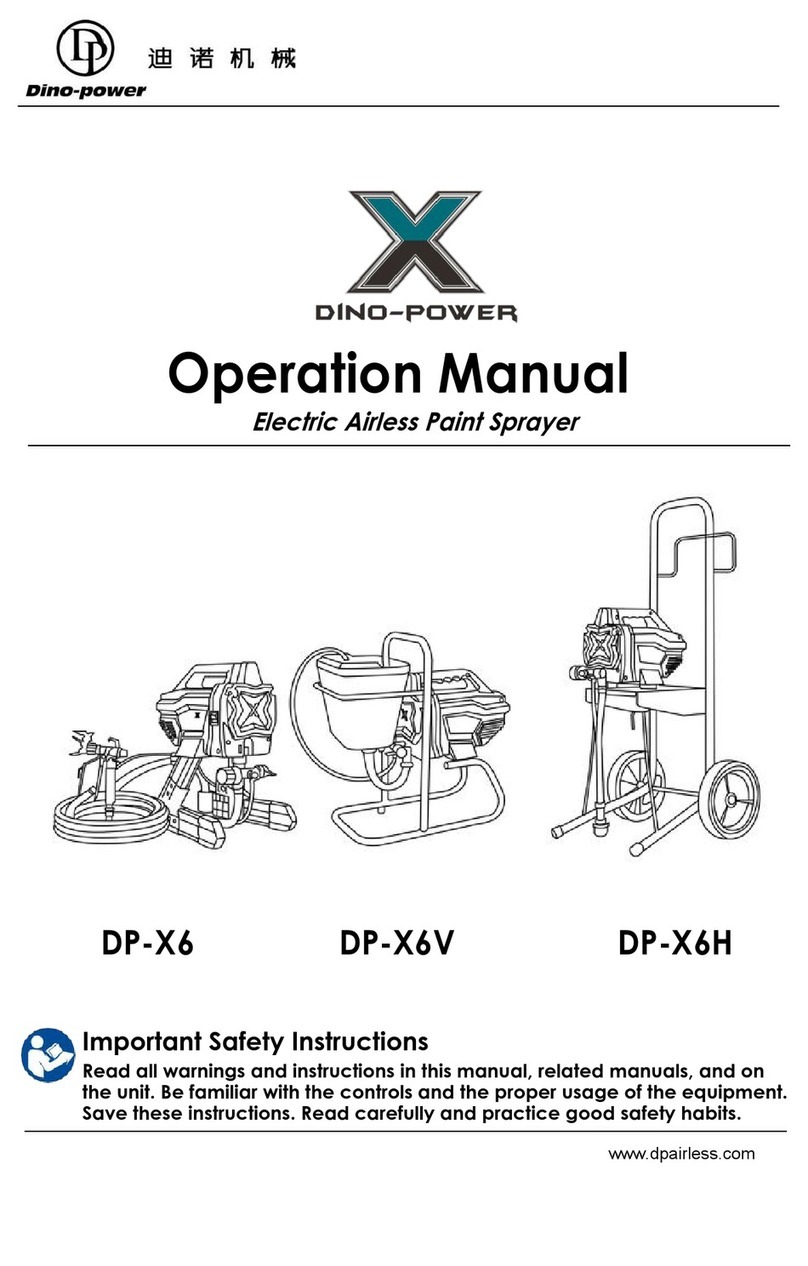
Dino-Power
Dino-Power DP-X6 User manual
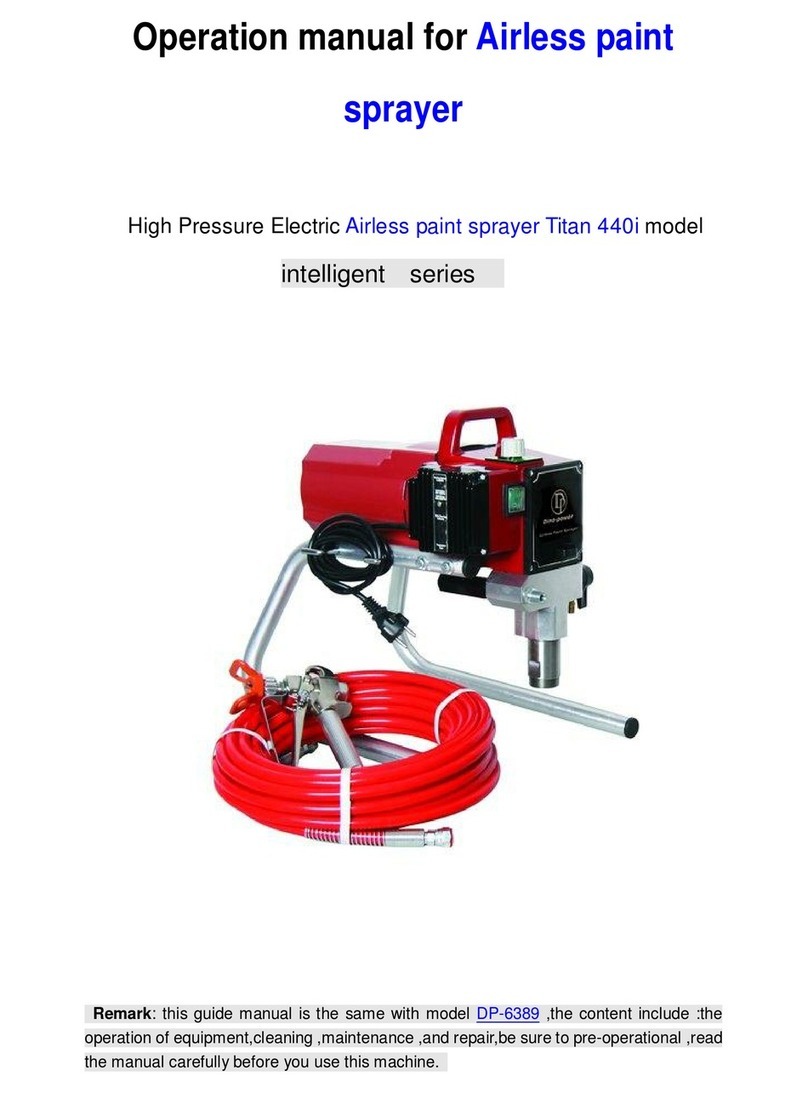
Dino-Power
Dino-Power Titan 440i User manual
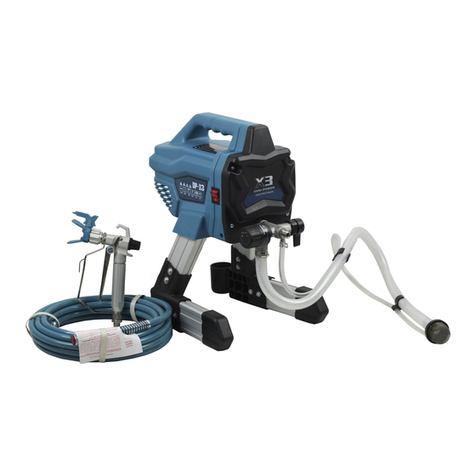
Dino-Power
Dino-Power DP-X3 User manual
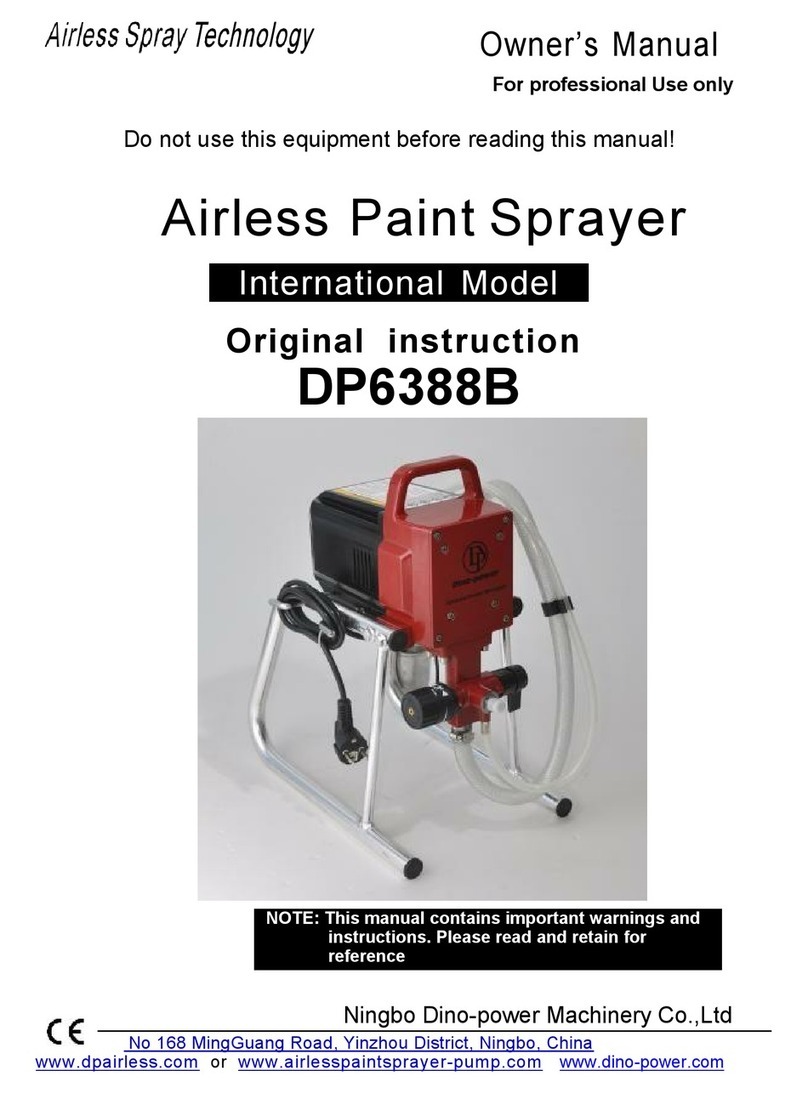
Dino-Power
Dino-Power DP6388B Operation instructions
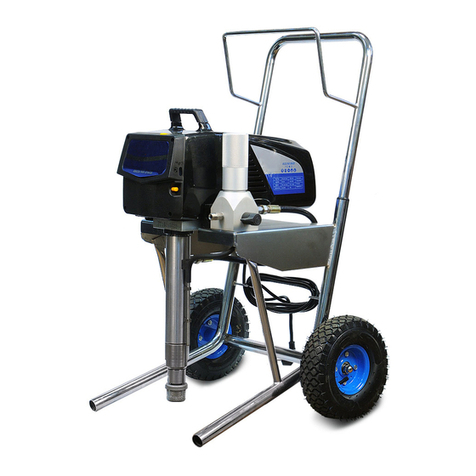
Dino-Power
Dino-Power DP-6336iB User manual
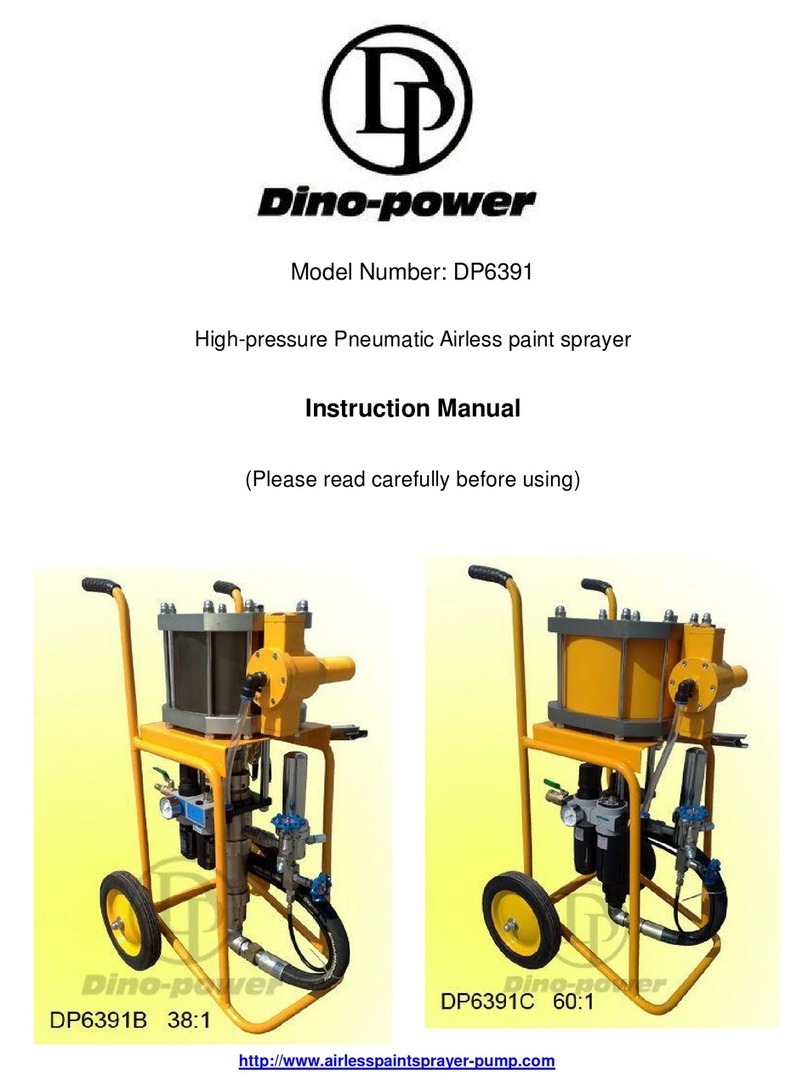
Dino-Power
Dino-Power DP6391C User manual
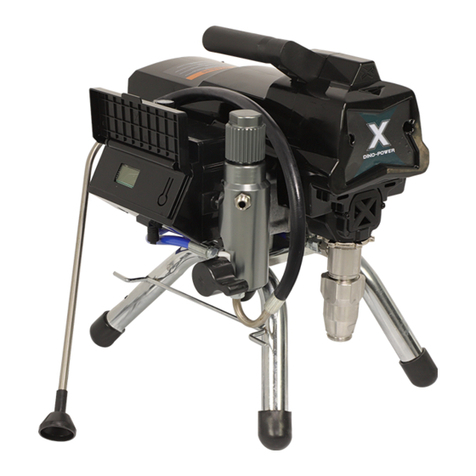
Dino-Power
Dino-Power DP-X Series User manual

Dino-Power
Dino-Power DP-X Series User manual
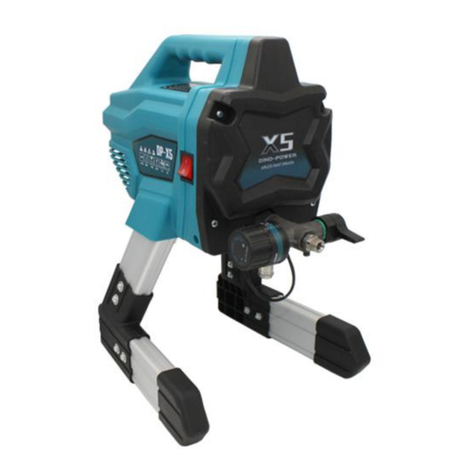
Dino-Power
Dino-Power DP-X5 User manual
Popular Paint Sprayer manuals by other brands
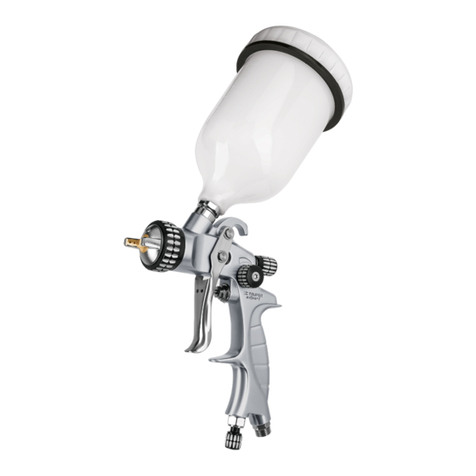
Truper
Truper PIPI-440X manual
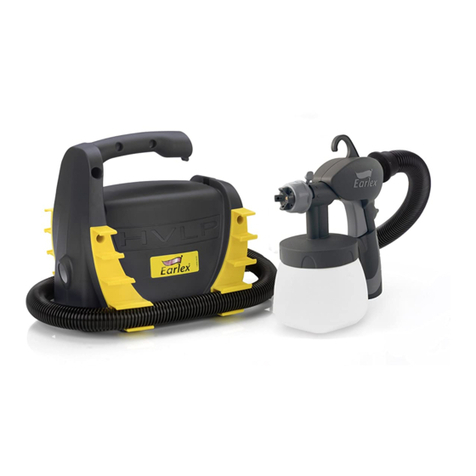
Earlex
Earlex SPRAY STATION HV 2900 Operating instructions manual

Magnum
Magnum pro Finex H5 HV3900VEUG Operating instructions manual

F/S
F/S UTV Series owner's manual

WAGNER
WAGNER FC3500 manual
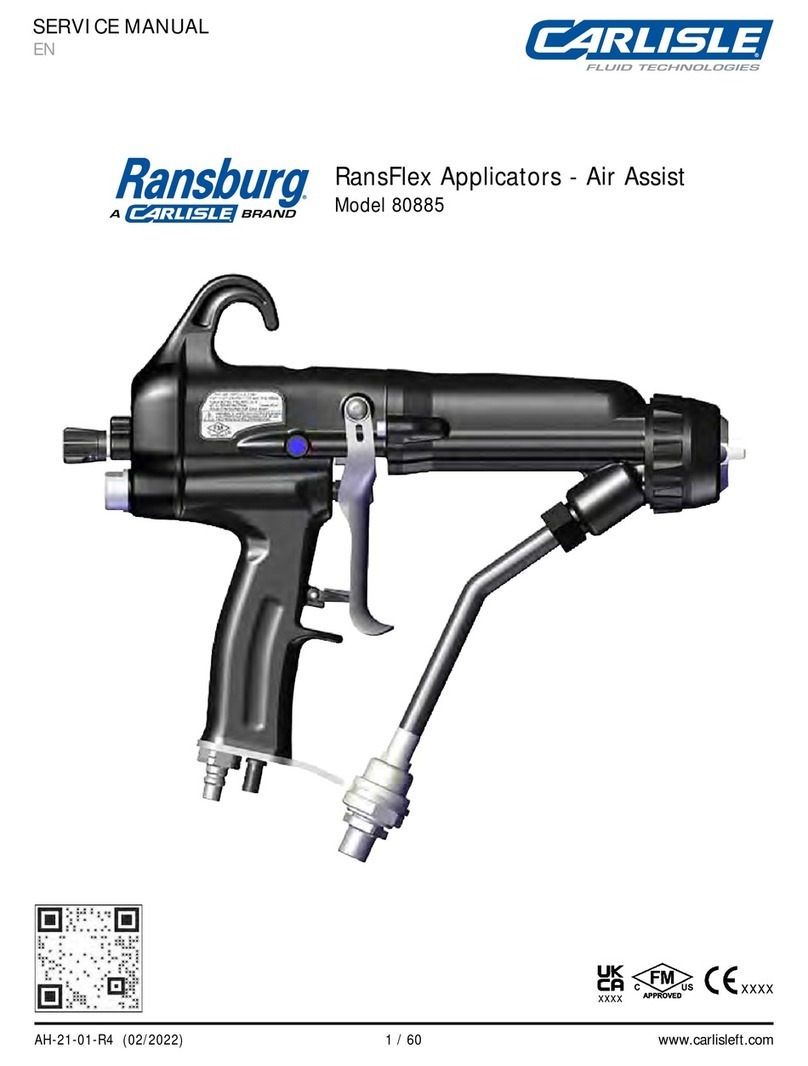
Carlisle Fluid Technologies
Carlisle Fluid Technologies Ransburg RansFlex 85 Service manual

